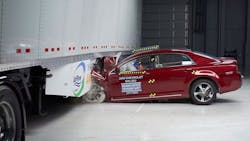Oral fluid testing
Ease of administration is a big reason for allowing oral fluid testing, “but probably the more significant one is to cut down on cheating on these tests. Urinalysis by its nature is very rarely an observed test,” Wiseman said, which gives drivers a chance to substitute or dilute their urine.
“By the nature of oral fluid testing, those are always going to be observed,” he said. “There’s always going to be somebody, a collector, right there.”
Wiseman said he does not expect oral fluid testing to increase drug violations significantly, but weeding out cheaters could create an uptick.
Speed limiters
Speed limiters are a controversial technology resisted by many trucking stakeholders. In its September 2023 Significant Rulemaking Report, the DOT stated that FMCSA is preparing a supplemental notice of proposed rulemaking to follow up with its joint 2016 NPRM with the National Highway Traffic Safety Administration. Trucks with a gross vehicle weight rating or gross vehicle weight of 26,001 lb. or more would require a speed limiter.
“On the FMCSA agenda for 2023 was supposed to be a supplemental notice of proposed rulemaking to reinitiate the talk about these speed limiters, and that got much blowback, as it did back in 2016,” Wiseman said. He noted that several lawmakers in Washington have also balked at the idea.
In September, FMCSA published, then removed, an exact number for the speed limiter—68 mph—from its notice of proposed rulemaking. The agency said the exact speed limit would be determined later.
See also: Can speed limiters and AEB really make highways safer?
Automatic emergency braking mandate
NHTSA and FMCSA proposed mandating automatic emergency braking systems on Class 3 and larger vehicles.
According to Fred Andersky, director of government and industry affairs and technical training, Bendix Commercial Vehicle Systems, the agencies are targeting April to issue a final rule. However, the mandate for manufacturers to install AEB technology on all new trucks wouldn’t take effect until 2027. The notice of proposed rulemaking states that a final rule will not require retrofitting for currently active vehicles.
Critics of AEB technology point out the systems can sometimes engage when they shouldn't, and Andersky acknowledged that false braking is an issue. To mitigate this, he said that it is essential that carriers train the drivers on the technologies, telling FleetOwner, “It’s crash mitigation, not crash avoidance.”
Andersky warned that drivers who push the pedal to the floor can override the collision mitigation technology. AEB systems contain driver overrides in which a driver who steers beyond a certain point or applies full throttle can deactivate the collision mitigation system because the system thinks the driver could be attempting to avoid a dangerous situation.
In order to ensure the AEB systems function as intended, fleets must inform drivers how to both activate and avoid these overrides. A speed limiter mandate by the federal government could result in more drivers instinctively pushing harder on the pedal to exceed the limiter's capacity.
“It is driver assistance, not driver replacement," Andersky said. "It’s good to know that the technology is there to back them up because even the best driver can have a bad day. And this helps it from becoming a really bad day.”
Andersky does not foresee maintenance of AEB systems being a barrier because suppliers like Bendix and OEMs make their diagnostic technology available for technicians. Fleets must ensure that tires and brakes are maintained, however, if the AEB systems work correctly.
Installing AEB technology would increase manufacturing costs, which could potentially be passed on to truck buyers, “but the cost that’s being added compared to the overall price of the vehicle is relatively small, and versus the benefit that can be derived, it is relatively high,” Andersky said. “Fleets wouldn’t buy this if they weren’t getting a return on their investment.”
Side underride guards
Last April, NHTSA published an ANPRM and a study mandated by the Infrastructure Investment and Jobs Act on side underride guards. NHTSA completed the study in 2022 and estimated that guards would save 17 lives and prevent 69 serious injuries annually.
In 2020, NHTSA calculated the total cost of installing underride guards on a trailer, including hardware costs and paying for an average of three hours of installation labor, to be $2,990. At 260,000 new trailers sold annually, the total annual cost for equipping all applicable new trailers with side underride guards would be about $832 million.
Equipping a new trailer with side underride guards is estimated to generate about $490 to $640 in lifetime safety benefits.
Some 2,000 individuals and organizations responded to agency questions during the extended comment period that closed in July. Key stakeholders broadly agree that NHTSA’s cost-benefit analysis is flawed.
The Truck Trailer Manufacturers Association, which represents domestic and international manufacturers responsible for approximately 90% of the heavy-duty trailers manufactured for use in the U.S., consistently has stated that it would support the implementation of side underride guards “if they ever become both justified and technologically feasible.”
However, TTMA suggests the assumed effectiveness of the side guards “seems unrealistically high” and calls for additional data on crashes, including seat belt use and crash angles, noting “significant gaps” in the areas protected by underride guards. Furthermore, TTMA has not seen any data supporting any significant benefit from side underride guards for impacts exceeding 40 mph.
DOT might not be aware of “the degree of customization” the trailer industry employs to meet customer needs, TTMA notes. Similarly, TTMA members expressed concerns about side underride guards, ground clearance, and the risks posed by damaged guards.
NHTSA has launched a stakeholder group to study the matter further in 2024.
Independent contractor rules
In January, the U.S. Department of Labor published a final rule designed to help employers and workers better understand when a worker qualifies as an employee and when they may be considered an independent contractor under the Fair Labor Standards Act. However, for many business and trucking interests, the latest federal analysis is not the government help they sought.
See also: Contractor or employee? Labor Department posts new rule
The rule takes effect on March 11 and rescinds the Trump administration’s 2021 Independent Contractor Rule, which the department contends is inconsistent with “the law and longstanding judicial precedent.”
The American Trucking Associations, in response, pledged to work with Congress to defeat the “ill-advised rule.”
“I can think of nothing more un-American than for the government to extinguish the freedom of individuals to choose work arrangements that suit their needs and fulfill their ambitions,” Chris Spear, ATA president and CEO, said. “More than 350,000 truckers choose to work as independent contractors because of the economic opportunity it creates and the flexibility it provides, enabling them to run their own business and choose their hours and routes. That freedom of choice has been an enormous source of empowerment for women, minorities, and immigrants pursuing the American Dream.”
The ATA statement argues that the trucking industry has used independent contractors “since the inception” of interstate trucking and that court decisions over the last 90 years have “continually reaffirmed the legitimate role” independent contractors play in the U.S. economy.
Emphasizing that the rule is misguided and that “radical California agendas have no place in federal policy,” ATA also pledged to oppose Julie Su’s nomination to lead the Labor Department. As Secretary for the California Labor and Workforce Development Agency, Su oversaw the implementation of the state’s controversial AB5, a law that essentially reclassified independent contractors as employees.






